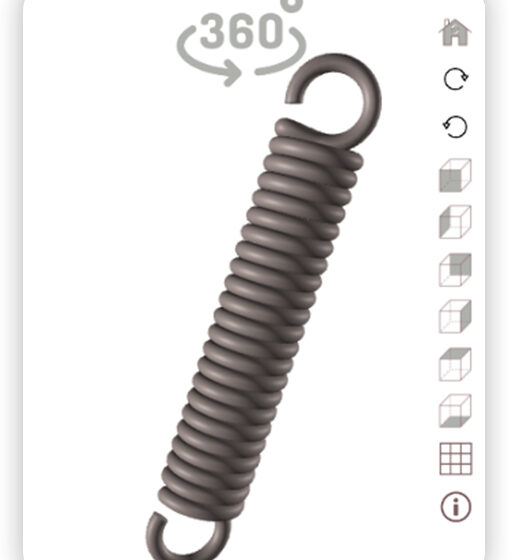Compression springs are a critical component in various mechanical systems, used to store energy and exert force. From the automotive industry to aerospace, electronics, and even consumer goods, compression springs play a vital role in ensuring that devices function efficiently. However, not all applications require standard, off-the-shelf compression springs. In many cases, businesses need custom-made compression springs that meet specific requirements. But how do compression spring manufacturers meet these unique specifications? Let’s explore the process, challenges, and how companies like Acxess Spring ensure their customers receive the ideal product.
What Are Custom Compression Springs?
Custom compression springs are designed to meet particular dimensions, load capacities, and performance criteria tailored to an individual application. Unlike standard springs that come in predefined sizes and materials, custom compression springs are engineered based on the specific needs of the customer. These springs can vary in terms of material, size, number of coils, and even spring rate (the amount of force required to compress the spring a certain distance). Custom springs are critical when off-the-shelf solutions do not meet the required standards or specific design criteria.
How Do Compression Spring Manufacturers Create Custom Springs?
Compression spring manufacturers follow a detailed process when designing and producing custom compression springs. It begins with a deep understanding of the client’s needs and technical requirements. Let’s break down the process into key steps:
1. Initial Consultation and Requirement Gathering
The first step for any compression spring manufacturer is to thoroughly understand the client’s requirements. This includes understanding the function the spring needs to perform, the load it will support, and the environment in which it will be used. For example, springs used in high-temperature applications may require heat-resistant materials, while springs in electronics need to be designed for fine precision. During this phase, manufacturers work closely with clients to gather all necessary information, such as the spring’s size, wire diameter, and material specifications.
Acxess Spring, for instance, has a dedicated team that helps customers outline these requirements and make sure they are on the same page before moving forward with production.
2. Material Selection
Choosing the right material for a custom compression spring is crucial. Different materials offer varying degrees of durability, flexibility, resistance to wear, and corrosion resistance. Manufacturers need to select a material that not only meets the specific functional needs but also complies with industry standards. Common materials for compression springs include stainless steel, carbon steel, alloy steel, and various non-corrosive metals.
For example, Acxess Spring uses high-quality materials to produce springs that meet high-performance standards, ensuring that customers receive a long-lasting, reliable product. They also offer various coating options to improve the spring’s performance in specific environments, such as powder coating, electroplating, or anodizing.
3. Design and Engineering
After gathering all the necessary data and selecting the right materials, the design process begins. Compression spring manufacturers use advanced CAD (Computer-Aided Design) software to model and simulate the spring’s performance. This digital design helps manufacturers test the spring’s performance before physically creating it, ensuring that it meets the required specifications.
The design stage is also when manufacturers determine the ideal number of coils, coil diameter, and the overall geometry of the spring. Special attention is paid to the spring’s rate, which defines how much force it can withstand per unit of compression. These calculations are important for ensuring the spring performs optimally in its intended application.
4. Prototyping and Testing
Once the design is finalized, the next step involves creating a prototype. This prototype is tested under various conditions to verify that it performs as intended. Manufacturers may test the spring for fatigue, stress, and longevity by putting it through compression and decompression cycles.
If the prototype doesn’t meet the specifications, the manufacturer can adjust the design and material choices and repeat the process. This iterative approach ensures that the final product is highly reliable and capable of performing in the specific application.
Acxess Spring, for instance, places a strong emphasis on testing, ensuring that each custom spring is robust enough to meet customer requirements in real-world conditions.
5. Manufacturing the Final Product
After successful prototyping, compression spring manufacturers move forward with mass production of the custom springs. The manufacturing process involves cutting, coiling, heat treating, and finishing the springs. For high-volume orders, automated machinery can create large batches of springs with high precision. For smaller orders, manual techniques may be used to ensure each spring meets the required specifications.
Quality control is an essential part of this process. Manufacturers perform thorough inspections at every stage to ensure that the final springs are within tolerance limits and meet the specifications laid out in the design phase.
6. Delivery and Post-Production Support
Once the custom compression springs are manufactured, they are packaged and delivered to the client. However, the role of a compression spring manufacturer doesn’t end there. Many manufacturers, including Acxess Spring, offer post-production support, which may include spring adjustments, additional testing, and troubleshooting if necessary.
Customers can rely on the manufacturer for advice on how to install or integrate the springs into their systems, ensuring optimal performance.
What Challenges Do Custom Compression Spring Manufacturers Face?
Manufacturing custom compression springs comes with its challenges. These challenges often arise during the design and prototyping phases and can include:
- Tolerances: Achieving precise tolerances can be difficult, especially for springs with small dimensions or high-stress loads. Even a slight variation in the dimensions of the spring can affect its performance.
- Material Selection: Finding the right material that meets all performance criteria can be tricky, especially when a spring must endure harsh environmental conditions such as extreme temperatures or corrosive environments.
- Load Requirements: Custom springs often need to handle specific loads. The spring must provide the exact force needed to compress, making the spring rate calculations highly critical.
To overcome these challenges, manufacturers must rely on advanced technology, engineering expertise, and experience. Brands like Acxess Spring are known for their ability to create highly precise and reliable custom compression springs, overcoming these challenges with a combination of cutting-edge technology and deep industry knowledge.
Why Choose Acxess Spring for Custom Compression Springs?
Acxess Spring is an industry leader when it comes to custom compression springs. Their extensive experience and commitment to high-quality manufacturing make them an ideal choice for any business in need of bespoke spring solutions. Whether it’s a large-scale production order or a small batch, Acxess Spring’s dedication to customer satisfaction and high-performance standards ensures that your unique spring specifications are met with precision.
With advanced testing methods, high-quality materials, and a design process focused on client needs, Acxess Spring is the go-to choice for custom compression springs that perform beyond expectations.
Conclusion
Compression spring manufacturers face the challenge of designing springs that meet unique specifications, requiring a detailed understanding of both engineering principles and the specific needs of the client. The process from consultation to manufacturing is complex and demands expertise. Custom compression springs, when designed correctly, ensure optimal performance in a variety of industries, from automotive to aerospace to electronics. By working with trusted manufacturers like Acxess Spring, companies can ensure that their spring needs are met with the highest standards of quality, precision, and reliability.



